Feature
Finding Team Clean
Partnering to Restore a Local Riparian Zone
Science Scope—April/May 2020 (Volume 43, Issue 8)
By KATHRYN A. BALDWIN, R. LANCE POTTER, ELI HOLM, KAT HALL, BRIAN WALKER, AND REBECCA HANSEN
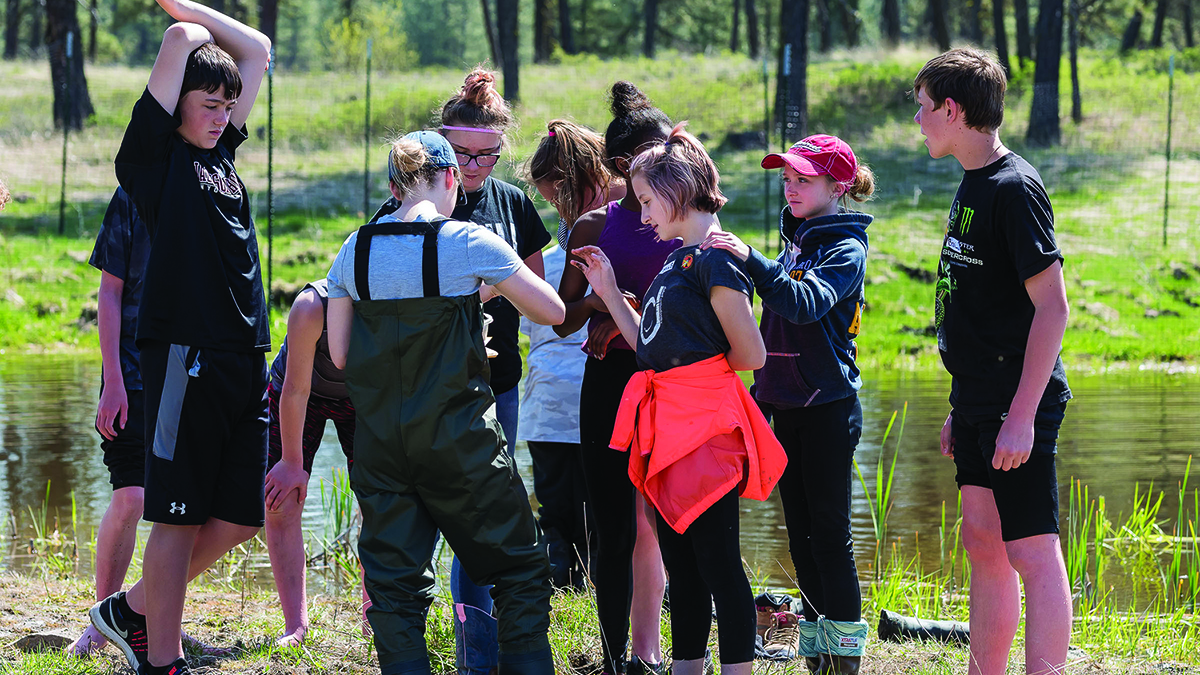
CONTENT AREA Earth Science and Life Science
GRADE LEVEL 6–8
BIG IDEA/UNIT Ecology
ESSENTIAL PRE-EXISTING KNOWLEDGE None
TIME REQUIRED
- One 45-minute class period
- Two full school days in the field
- One 2-hour evening
- Plus supplemental preparation and follow-up activities at the middle school.
COST Varies. In this case, there was no cost to the school as the partners paid for all equipment and bus transportation.
SAFETY Students should receive safety instructions on how to safely work with shovels.
Seventh-grade students, standing in the riparian zone of Marshall creek, a small creek in a wetland area near their school, hover around a washtub. They want to see what came out of the water they just sampled by using a large D-net and gently skimming the surface of a new pond. The middle schoolers seem surprised at how much life is in a small sampling of the water. “Look at all that!” and “What is that?” are just a few of their comments. Then the students start using an identification key to try and identify benthic macroinvertebrates—“Look, a caddisfly,” to which another student yells, “TEAM CLEAN!” This is just an example of one day in an Outdoor Environmental Education Partnership program developed by a university, a local area middle school, The Lands Council (a local conservation organization), and the U.S. Fish and Wildlife Service’s Partners for Fish & Wildlife program—a partnership with major benefits to all partners.
Outdoor environmental education is nothing new. It is difficult, however, to develop and sustain meaningful programs. Washington State’s standards mandate environmental and sustainability education (see Resources) in which “students engage in inquiry and systems thinking and use information gained through learning experiences in, about and for the environment” (p. 6; italics added).
Research has supported the inclusion of outdoor environmental education in school programs. Theimer and Ernst (2012) studied several U.S. Fish and Wildlife Service education programs and concluded that environmental education can positively impact students’ feelings of connectedness to nature. King and Ginns (2015) studied middle school students in Australia and found that weekly visits to a nearby creek supported by classroom lessons led to meaningful learning about science and enjoyment of science compared with other science units. James and Williams (2017) conducted a study of 56 seventh- and eighth-graders in Wyoming who enjoyed a two-day, one-night experiential outdoor event. The authors noted that students who were often disengaged with traditional classroom learning became “motivated and immersed” during their outdoor learning experience (p. 67).
Project goals
The goals of this project are three-fold. First, all partners wanted to engage young people with their local environment to begin to inculcate values of environmental stewardship. Second, the university wanted to create opportunities for preservice teachers to experience hands-on outdoor environmental education in hopes that one day, when they are in their own classrooms, they will endeavor to engage their students in outdoor environmental education. Third, The Lands Council and the U.S. Fish and Wildlife Service wanted to actively incorporate volunteers, and specifically local students, in restoring riparian areas in the local watershed to improve habitat and water quality. The purpose of this article is to describe how we built a partnership to help meet the goals of all partners (see Figure 1). We hope that by sharing information about this partnership, we can motivate and guide others to do the same.
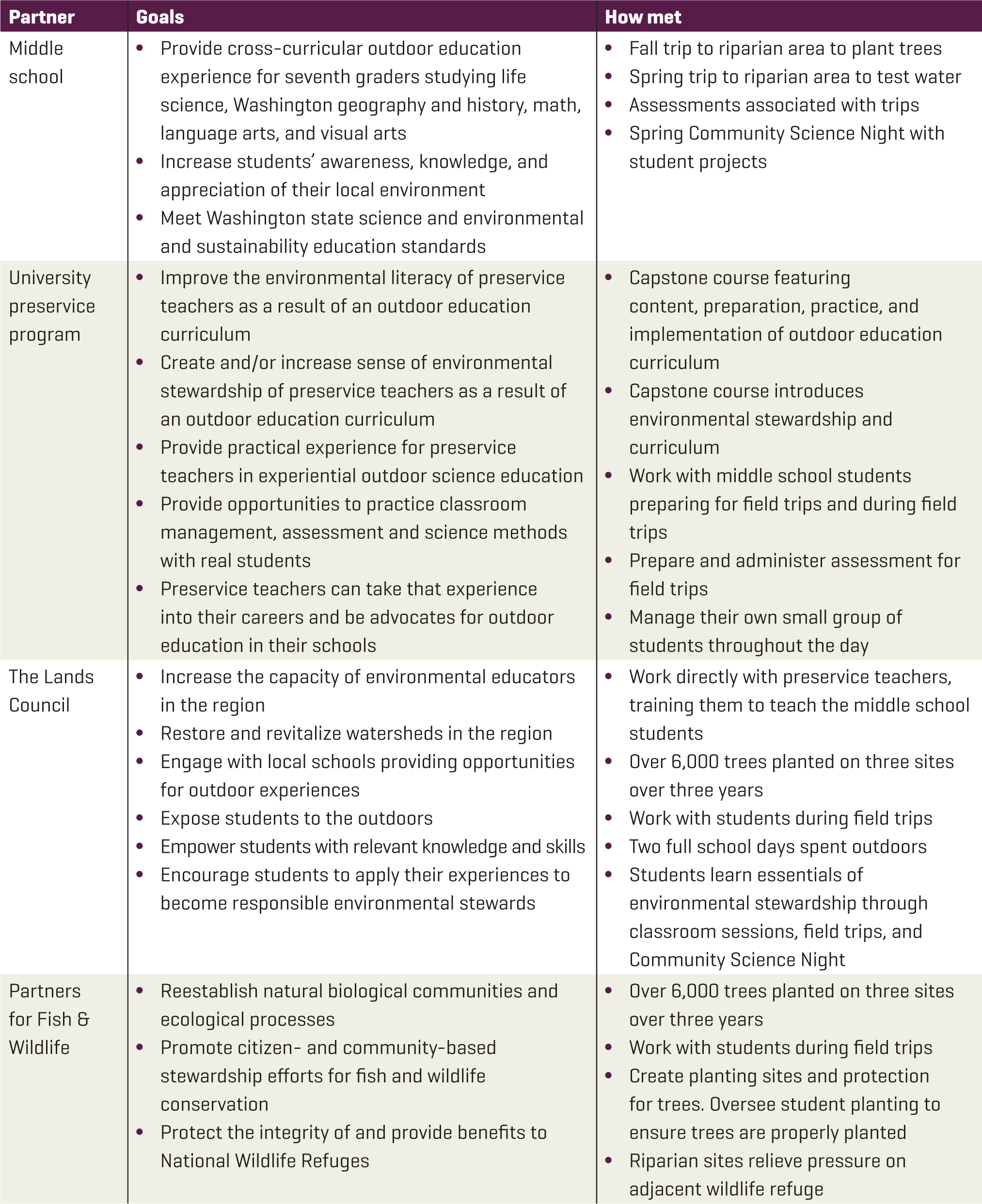
Partnership goals
Building the partnership
University professors from a teacher preparation program wanted to integrate environmental education and conservation stewardship into a senior year capstone project within the community. After speaking with a local area middle school’s administration, we found they too wanted to provide their middle school students with an outdoor environmental education experience.
We knew that partnerships were essential to make the project successful, but the difficulty was finding partners outside the school willing to work with middle school students on a large scale. Through connections in the local education community, we found out about a local conservation organization, The Lands Council. This organization wanted to partner with schools in the watershed of a degraded stream system it was working to rehabilitate, and its people knew of private lands that needed to be restored, landowners interested in the project, and our final partner—the U.S. Fish and Wildlife Service’s Partners for Fish & Wildlife program. Once we all found each other, our partnership was forged and has flourished.
Planning for the year
While the U.S. Fish and Wildlife Service worked to prepare our site, the university professors, the school’s assistant principal and select teachers, along with The Lands Council’s conservation and education director met twice to discuss the goals of the partnership (see Figure 1). By aligning project goals with the Next Generation Science Standards (NGSS Lead States 2013), together we outlined an ecology unit for the year. The second meeting outlined a timeline and lessons to achieve the desired outcomes (see Figure 2). In addition, the school’s teachers developed supporting lessons in science. The language arts teachers, social studies teachers, and art teacher also reported “weaving in” the ecology unit to their subjects to stress the interdisciplinary nature of environmental education.
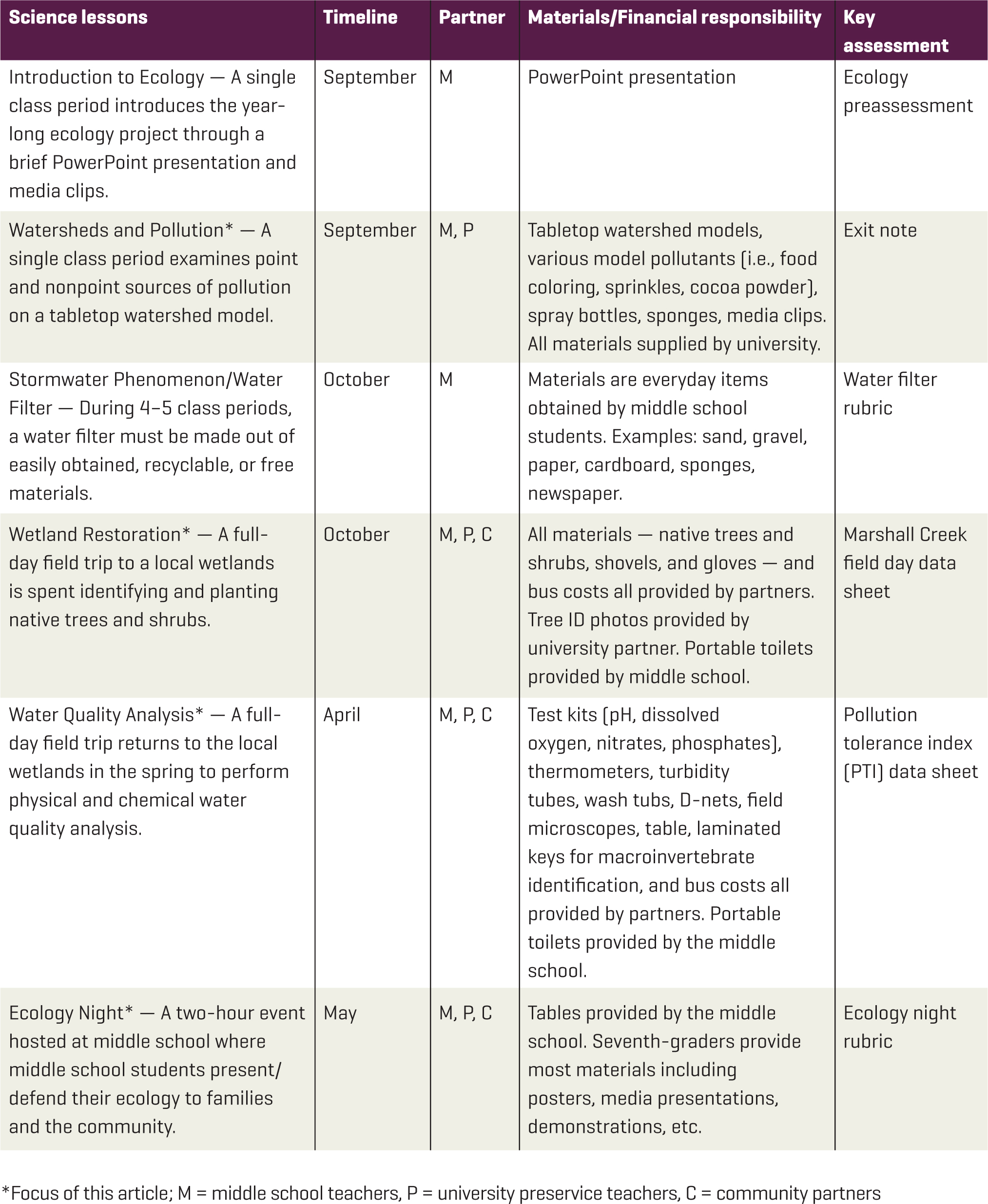
Partnership summary
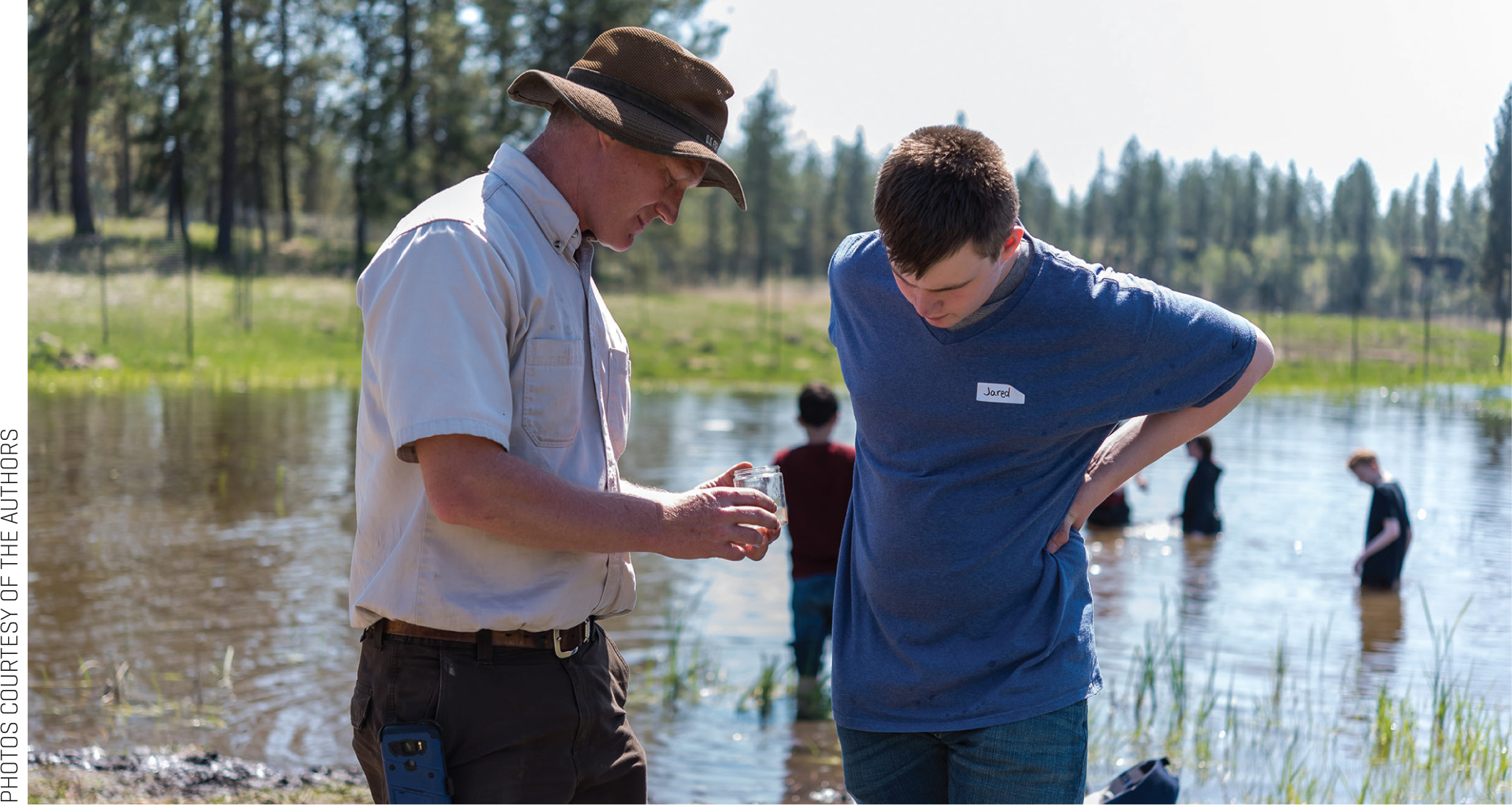
Partners for Fish and Wildlife biologist, Brian Walker, shares macroinvertebrates with curious student (photo by Bridget Mayfield, Pescado Lago Studios).
The project
The yearlong project consists of four distinct parts: watershed and pollution education, wetlands restoration, water-quality analysis, and a community ecology night. The watershed and pollution education portion takes place at the middle school. The university preservice teachers provided four tabletop watershed models to discuss the effects of point and nonpoint sources of pollution. Using four models allowed the teachers to break students into groups of about eight, which allowed for engagement in the model for all students. Without access to multiple models, one could use a station approach to keep the numbers interactive.
The watershed restoration portion takes place in the field on private lands and involves planting trees and shrubs in the fall. It is led by The Lands Council and the Partners for Fish & Wildlife program biologist with active support from the university preservice teachers. The water analysis portion finds students returning to the field site in the spring to conduct a variety of tests on the water. One activity (see Resources for Pollution Tolerance Index [PTI]data sheet handout) asks students to identify Team Clean indicator species and determine the pollution tolerance index. Finally, under the guidance of middle school science teachers, the year wraps up with an ecology night at the middle school with students presenting ecology projects to their family and the community (see Figure 2 for more details about materials, assessments, etc.; see Online Supplemental Materials for the Ecology Night Rubric).
One concern the partners had was how to make a safe, educational, and fun experience for all students regardless of ability or prior interest. Some schools might make students earn the privilege of participating to keep the project size manageable, keep costs down, and minimize behavior concerns. One potential partner even turned us down because of the large number of students we wanted to involve. The leadership at the middle school, however, was insistent that as many students as possible be included. Each year for three years about 160 middle school students (~90–95%, including all but those who presented a safety concern or did not return parent permission forms) have participated in the project.
Partnership—key to success
Building a partnership was the key to the project’s success. With a large group like this, the partnership allowed everyone to share resources and expertise to help manage students and time, as well as equipment and costs. Including all students might not be possible if this rested on the middle school alone. Partner roles were discussed with all partners at one of the preproject meetings (see Figure 1).
The presence of the preservice teachers allowed us to improve classroom management and safety by utilizing small groups of students (8–10), where all students could be involved and constantly supervised (see NSTA Safety Advisory Board 2015). University preservice teachers applied classroom management, assessment, and science methods coursework onsite. Preservice teachers got to know the students in the classroom setting before taking them outside and set field-trip ground rules before getting off the bus. Preservice teachers could also quickly check for understanding (e.g., what are the three benefits of planting trees?), redirect off-task students, and/or use an inquiry-based approach in the field. In addition, the seventh-grade teachers were very conscientious about creating balanced groups that would work. They considered gender ratios, readiness, learning profiles, student interests, behavior, and 504 and IEP plans. The diversity of the middle school student population is 45% free and reduced lunch, 76% white, 12% Hispanic/Latino, and 21% students having either a 504 or IEP plan. Some students also had one-on-one paraprofessionals come with them. Last, the partners managed the details, such as planting locations, planting materials, and water-quality testing supplies, on the project sites.
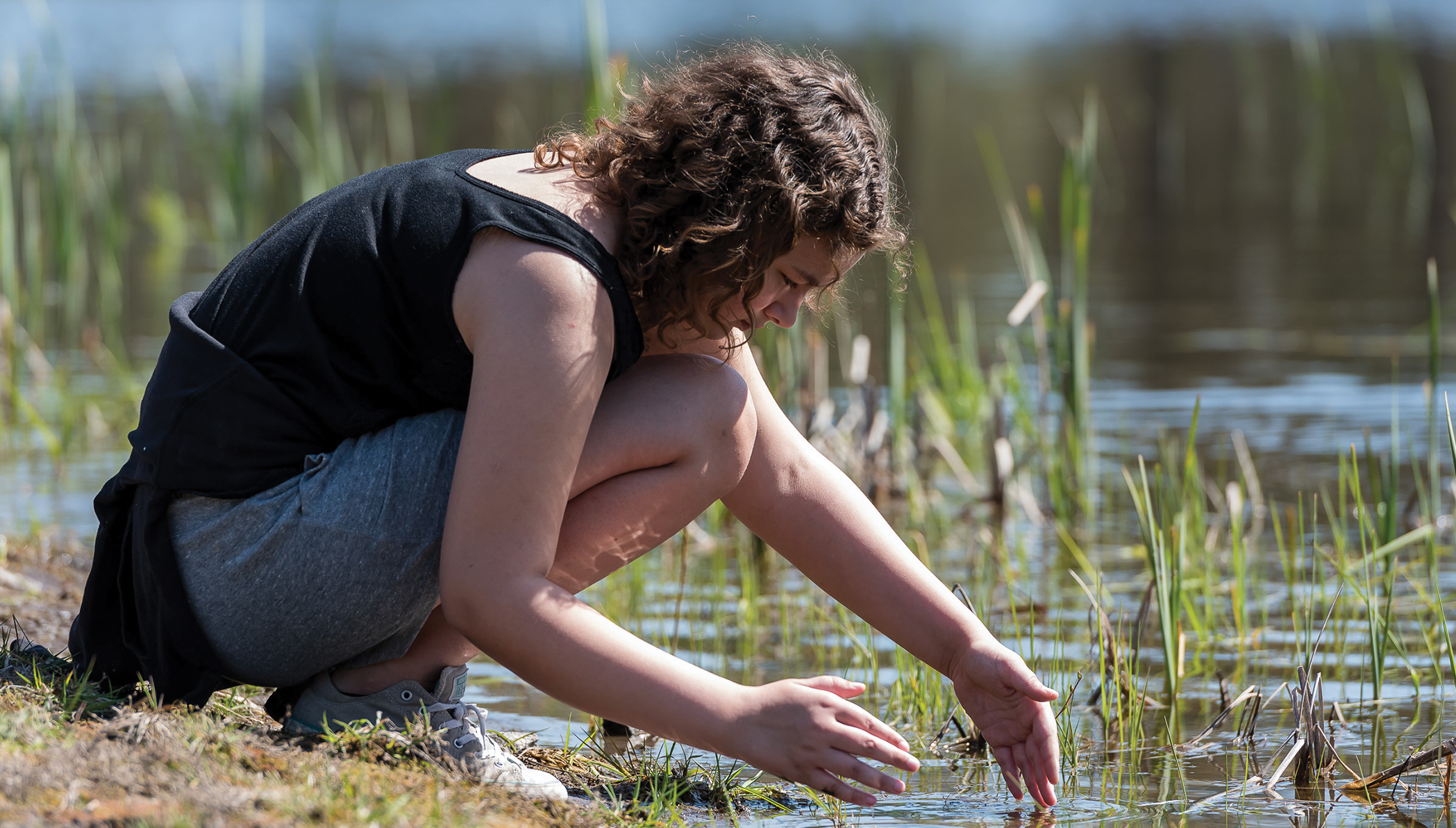
Middle school student examines the water for aquatic life (photo by Bridget Mayfield, Pescado Lago Studios).
The fall planting outing serves as a great example of the partnership. The middle school leadership arranged for transportation and other trip logistics, such as having a portable toilet onsite. Our conservation partners prepared the site by predigging holes and providing shrubs, saplings, and tools. They also provided orientation and initial instruction. The preservice teachers led their groups in their planting efforts and supporting activities with students. There was always plenty of support nearby. While the preservice teachers taught and monitored their groups, conservation organization staff and the university professors roamed the worksite, assisting the preservice teachers, engaging with students, giving help where needed, and pointing out interesting observations like moose tracks and other signs of wildlife. This left the middle school teachers and school administrator available to manage any discipline issues. (Fortunately, the behavior problems have been very minimal.) In addition, by nature of the project, students could engage in the manner differentiated to fit their needs. For example, students planted trees at various speeds; some worked alone, others with partners, and some shuttled trees to planters. As an assessment, students completed a worksheet (see Figure 3). Students were able to do this on their own, with a partner, or with the help of their group leader.
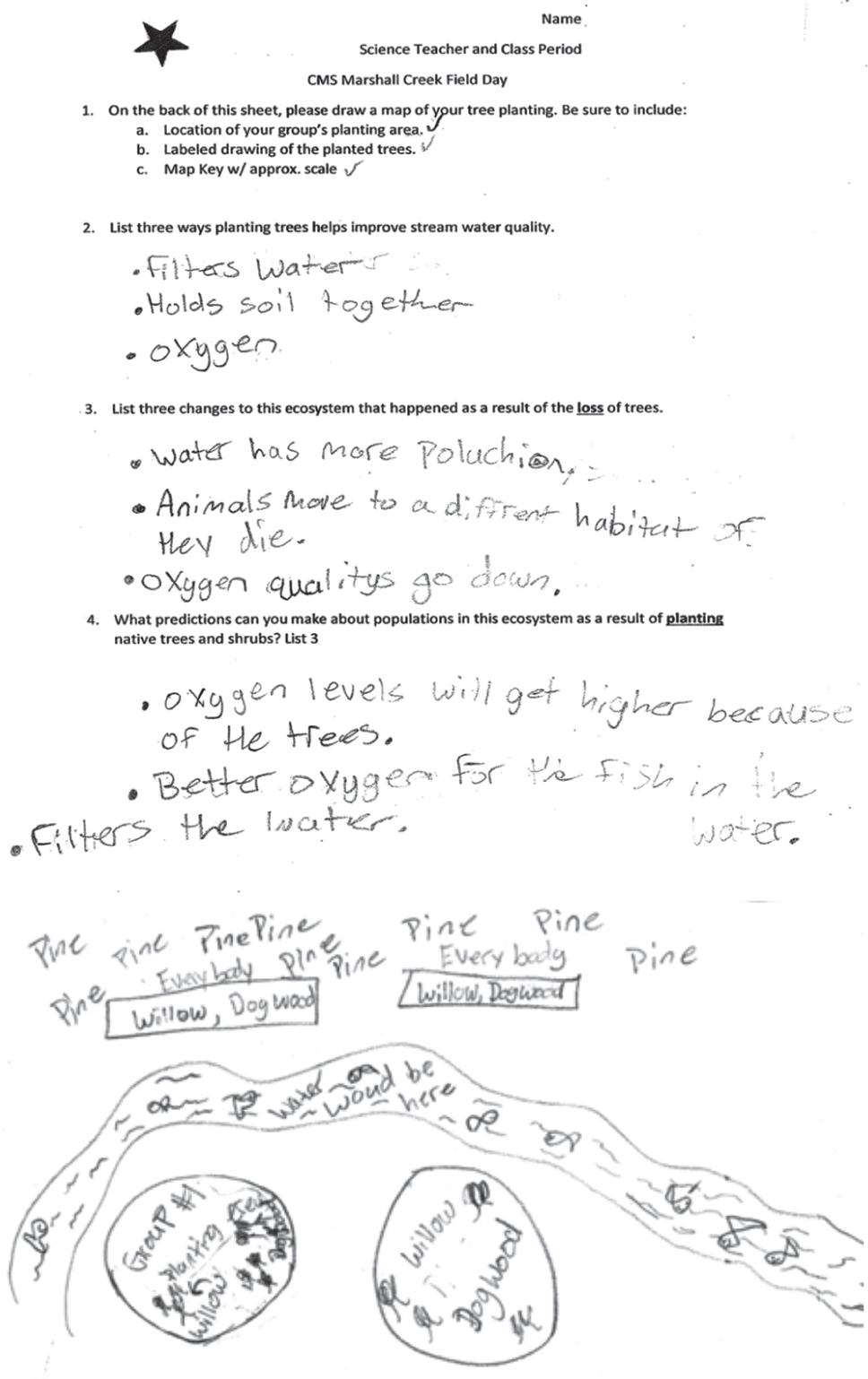
Finding Team Clean field day assessment worksheet
Benefits of the project
The middle school
The biggest success of the project was to see students so engaged in the work. Teachers and administrators from the middle school remarked that many of the most engaged students had sometimes struggled in regular classroom settings. We found almost all students enthusiastically planting trees in the fall and eagerly testing the water for living organisms in the spring. The support and encouragement of the school administration were critical for clearing the path for this project to move forward. We initially worked hand-in-hand with the school’s assistant principal to plan the activities. He engaged his teachers and found them willing and eager to help plan cross-curricular activities for the school sessions. Since the initial year of the project, the assistant principal has worked on turning over more responsibility to his teachers to take care of the details of the school’s side of the project. It would be very difficult to enter a project like this without support from the administration and buy-in from teachers.
In addition to the anecdotal comments about the middle school students’ positive attitudes about being outdoors, the middle school teachers indicated a significant increase in content knowledge. On a pre/post style content test, middle school students demonstrated increased vocabulary and ability to answer both true/false and short-answer questions about ecology. For example, while the average pretest score for the question “Describe the 3 functions of a riparian buffer in a river/stream” was only 12%, posttest averages increased to 78%.
Community partners
The partnership formed to run and sustain this project has been a “win” for all parties. The conservation organizations are ecstatic about the impact on the middle school students. The long-term outcome is that these students will become conscientious environmental stewards. Each time the partners see each other for another learning event is a time for heartfelt affirmation and encouragement. Finding willing and enthusiastic partners makes the work of all partners easier. We suggest looking for partners who have many of the same goals. One of our partners, the U.S. Fish and Wildlife Service, is a good starting point for a partnership because it offers the Partners for Fish & Wildlife program in every state. Many of those programs have requirements to work annually with school groups on various projects under the Connecting Youth with Nature initiative, Schoolyard Habitats, and Outdoor Classroom programs.
In addition, in most large cities there is usually some type of local environmental organization. Even some of the smaller cities have members from larger groups (Sierra Club, Trout Unlimited, Ducks Unlimited), and those members can usually get teachers or other educators into contact with the main group. Other sources of expertise are conservation districts and local land trusts. Asking around at an Earth Day event or community cleanup can really open doors, as almost all groups are looking for volunteers for some kind of project. When those volunteer activities line up with what the school is doing, or can be modified to encompass what the school is doing, then all kinds of options open up.
The university
Preservice teachers are instrumental not only in guiding their groups, but also in taking responsibility for the initial training of students and creation of activities and assessments in the field. For this project, preservice teachers gained experience in working outdoors, and many commented that they were inspired to do some kind of outdoor environmental lesson once they had their own classroom. Many preservice teachers also commented on how they didn’t realize that students would be so enthusiastic about being outdoors and the impact on content knowledge. If there is no college or university nearby, parents or volunteers from local conservation organizations can be solicited and trained to help.
Costs of the project
Without the partnership, the costs would be prohibitive for the middle school. For example, on one site we planted 4,500 trees. The Partners for Fish & Wildlife program biologist estimates that if the trees/shrubs had been purchased by the school, it would have cost roughly $45,000, just for plants. This amount does not include fencing for the site or site preparation time of the partners. That is where the partnership is crucial. The partners were able to buy things like soil, pots, and fencing in bulk, and plants as bare root seedlings. We were fortunate that our partners provided most materials (trees and shrubs, shovels, gloves, water sampling kits, nets, invertebrate identification cards, magnifying glasses, and site preparation materials). The university preservice teachers provided four tabletop watershed models (~$600/each). The Lands Council secured and paid for the two school busses for two days in fall and spring (~$700/fall and ~$700/spring) using an EPA grant. This made the cost to the middle school almost zero. Another savings in the partnership is time. If The Lands Council or Partners in Fish & Wildlife program had been tasked with planting 4,500 trees alone, the planting portion of the project would have been scaled back or contracted out at considerable expense. Working with the partners, the overall cost of the planting project was reduced, and in some cases planting areas expanded because of the number and enthusiasm of student volunteers.
Challenges of the project
In three years, we have been on three different properties. Our conservation partners recently found a property to work on next year. The presence of grant money, however, is probably essential to sustaining the project to provide materials and transportation to the site. Another challenge is providing the preservice teachers, who are drawn from elementary education majors. Many of these teachers lack outdoor experience themselves or are used to working only with younger students. The weather is also a challenge at times. Our first year, a forecasted windstorm delayed our initial outing and necessitated taking all 150 students on the same day. This year, steady rain and cold weather shortened one water sampling outing. The keys to handling unforeseen circumstances are flexibility, communication, and resilience. The logistics of monitoring so many students is another challenge. The preservice teachers proved valuable in this regard, keeping close tabs on their groups and applying their knowledge of classroom management, assessment, and science methods in the field. It is essential that the activities are engaging. The time allotted to each activity is important as well. The middle school teachers served as valuable resources as far as understanding how long each activity would engage the students’ interest. Over the years we have modified our outings in response to the experiences in prior years.
All groups involved—the middle school, the university, and the local conservation groups—echo the fact that forming the partnership helped to overcome the challenges associated with this type of project. The conservation groups gained volunteers to restore the wetland. In all, the middle school students have planted about 6,000 trees. The preservice teachers gained experience in an outdoor classroom. Most important, the middle school students gained an understanding and appreciation of local ecology. This partnership is a great way to begin building the next generation of Team Clean stewards of the land.
Note: The findings and conclusions in this article are those of the author(s) and do not necessarily represent the views of the U.S. Fish and Wildlife Service.
Kathryn A. Baldwin (kbaldwin1@ewu.edu) is an assistant professor and R. Lance Potter is an assistant professor, both in the Department of Education at Eastern Washington University in Cheney, Washington. Eli Holm is an assistant principal and athletic director and Rebecca Hansen is a teacher, both at Cheney Middle School in Cheney, Washington. Kat Hall is the conservation and education director at The Lands Council in Spokane, Washington. Brian Walker is a private lands biologist with the U.S. Fish and Wildlife Service in the Pacific Region, stationed at Turnbull National Wildlife Refuge near Cheney, Washington.
Environmental Science Labs Middle School


